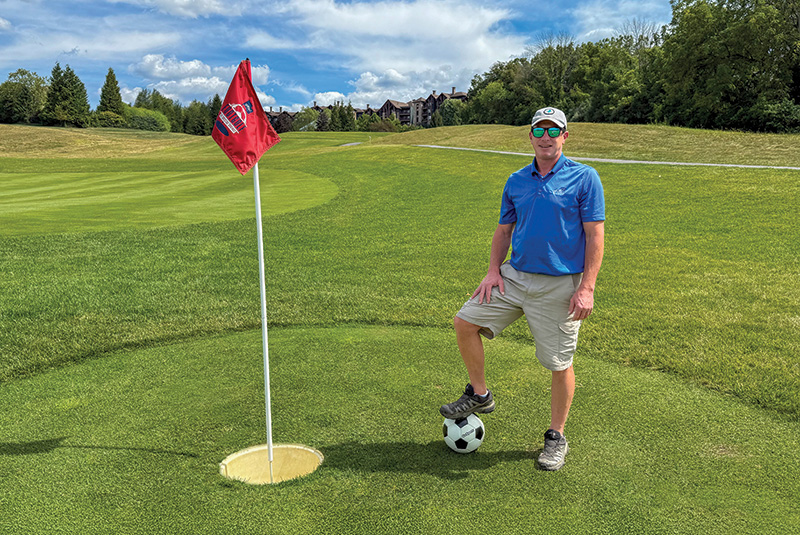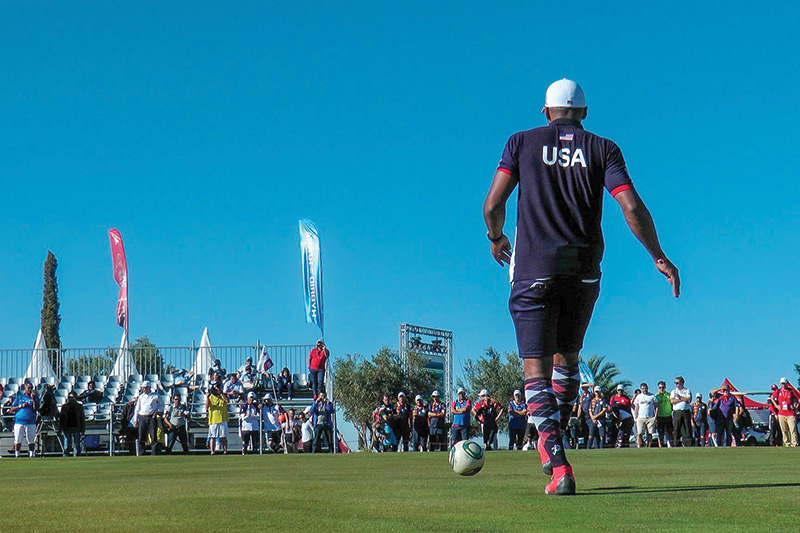
Crystal Springs Resort golf course superintendent Mike Paluzzi was instrumental in making FootGolf happen at the New Jersey facility. Photo courtesy of Sarah Kane
For more than two decades, GCSAA Class A golf course superintendent Mike Paluzzi covered a lot of ground via foot or riding equipment at Crystal Springs Resort. On one occasion, this on-site trip was way different than the others.
After all, it wasn’t every day he toted soccer balls around the place.
“We walked the course, kicking the soccer balls to implement and design our own FootGolf course,” says Paluzzi, a 30-year association member who recalls that game-changing experience barely more than a decade ago at Crystal Springs in Hamburg, N.J. “This was new.”
Not anymore.
In those days more than a decade ago for Paluzzi, it was the new game in town for many in America. The American FootGolf League (AFGL) was founded in November 2011. One year later, on July 22, 2012, the inaugural FootGolf tournament in the U.S. was held at Chula Vista Resort in the Wisconsin Dells.
The U.S. got the hang of it. More to the point, the country got a kick out of it.
At one time, approximately 500 golf courses in the U.S. added FootGolf to their activity options. The growth, however, hit a snag. The COVID-19 pandemic had much to do with it. But once golf courses reopened and served as a playground for people to escape their lockdowns and homes, golf was a haven. Tee sheets were available, but a tee time on the tee sheet was not available at some locations. Golfers flooded courses nationwide. For FootGolf, in numerous instances, it was set aside. Or even vanished during golf’s explosion.
The end of FootGolf? Not so fast. It looks as if it’s making a comeback.
A friend indeed
Roberto Balestrini is all about the golf industry. That certainly goes for superintendents, too.
“Superintendents now understand what 15 years ago was a mystery for them. They and their golf courses have taken advantage of real estate without making many changes and modifications,” says Balestrini, who is co-founder with his wife, Laura, of the American FootGolf League.
Before this goes any further, a little history of FootGolf. It reportedly began overseas many years ago, at international venues including the Netherlands and Hungary, before spreading to both South and North America. How does it work on a golf course? Players kick a regulation No. 5 soccer ball, navigating bunkers, tees, water hazards, etc., aiming at the bottom of a 21-inch-diameter cup. Holes cover a variety of distances — and sometimes are played alongside traditional golfers — from as little as 60-something yards up to 225 yards or more. The main objective is to score with the fewest kicks possible.
After its initial launch, AFGL leaders toured the country and hosted promotional tournaments. Those events served as an introduction. By 2014, the AFGL elevated its visibility and started the U.S. FootGolf Pro-Am. The new series of events focused on bringing the level of play in the U.S. up to par with countries worldwide. To attract players, the AFGL offered the first-ever cash prize.
Nationally, FootGolf slowly but surely flourished. “When golf was diminishing, we grew,” Balestrini says.
That is, until the pandemic rocked the world. Those half-a-million FootGolf rounds throughout the U.S. served as a high point for FootGolf. Soon, its presence was quieted. What was next?

Youth get a kick out of FootGolf and courses that include Walt Disney World Resort. Photo courtesy of Walt Disney World Resort
A downturn
Kevin Fateley saw it coming.
In the heartland, FootGolf was a hit at first for Fateley, a 36-year GCSAA member who with his wife, Beth, own Wildcat Fitness & Fun in Manhattan, Kan. FootGolf was a pleasant surprise to him at the beginning. “Early on, I didn’t think it would be a fad. Overall, in the time we had it, we made about $100,000,” Fateley says. “It cost people $10 to $12 a round. It cost us $4,000 to do this. The ROI (return on investment) was good. We mainly had high school and college kids.”
Once the pandemic struck, things changed. “It started waning around COVID,” says Fateley, “and what was disappointing was, most kids could not get through (a round of play). Young kids wanted to be home on their devices.”
Even since the worst of the pandemic seemingly has dissipated, Wildcat Fitness & Fun still decided to end its FootGolf ways. Fateley says he still is asked from time to time whether the course has FootGolf. Some questioners saw old advertisements for it. He isn’t planning on bringing it back. Even his quest to sell the aluminum cups for the holes was rejected. “Parks and rec weren’t interested,” Fateley says. “I ended up turning them in for recycling.”
As a FootGolf leader, Balestrini understood why the game slowed. “At first, even golf courses closed during COVID,” he says, “but they slowly reopened. FootGolf was put on their back burner.”
Not entirely — and not forever, it appears.
A resurgence
Social media played a role in what is happening at Fox Hills Golf & Banquet Center.
Eric Niemur, CGCS, is at the facility in Plymouth, Mich., and is an officially accredited AFGL course. Owners at Fox Hills learned about FootGolf through the National Golf Course Owners Association. “Our par-3 course (when it solely was golf) was doing OK. Breaking even. We looked at ways to spark new interest,” says Niemur, a 32-year GCSAA member.
They decided to go for it with FootGolf. Google reviews regarding FootGolf there signaled it was a wise decision. “We had Google reviews in the summer when I looked at it. Three out of four at the time were about FootGolf. I actually was surprised,” Niemur says. “Three out of four (reviews) raved. It boomed for a while. I wasn’t expecting it.”
Fox Hills embraced the hybrid sport. Another aspect of FootGolf’s draw is apparel that Niemur has witnessed at Fox Hills. “People dress up in knickers, fancy clothes. They take it pretty seriously,” Niemur says. “You can tell when they’re out there.”
Apparently, those FootGolf fanatics are returning in promising numbers. The AFGL says they are on the comeback trail. The days of 500 or so golf courses featuring the sport have not returned. Not yet. But stay tuned.

FootGolf has made its presence known for young and old in the U.S. and worldwide. Photo courtesy of the American FootGolf League
A draw at Disney
What better place to see that FootGolf is here and hopefully here to stay for those who cherish the sport than a locale such as Walt Disney World Resort?
The nine-hole par-3 Oak Trail Golf Course has offered FootGolf since 2018. “It’s a great venture for us. We wanted to increase utilization of Oak Trail,” says Alex Forsyth, director of sales and marketing for Walt Disney World Resort in Lake Buena Vista, Fla., who likes the crossover aspect of FootGolf and traditional golf. “It brings families, young kids, up-and-coming youth. Soccer is one of the nation’s fastest-growing sports. It just seemed to be a perfect fit.” When Walt Disney World was considering it, Forsyth reached out to the Balestrinis. He liked what he heard. “Very inexpensive, quick setup, minimal impact to the pre-existing golf operation, and a significant return on investment from the very beginning for us,” says Forsyth, a PGA member who plays FootGolf himself.
The future of FootGolf
To view how far FootGolf has come in the U.S. and where it may be going is worth a look in the time machine.
When FootGolf surfaced 14 years ago in America, Balestrini recalls a conversation with a woman at a club in Florida. “She said, ‘How do you kick a golf ball?’ It was a little bit frustrating, and it was a bit new for everybody,” Balestrini says.
Some of the frustration that was evident in those participation-dropping numbers five years ago is being soothed with optimism for him. In the pre-pandemic days, FootGolf didn’t need marketing, Balestrini says. Golf facilities were seeking them, until the pandemic led to a rise in golf and fall in FootGolf. About three years ago, though, facilities wanted to take another look at implementing FootGolf. “Courses were calling us again, and we weren’t knocking on doors,” he says.
Laura Balestrini won’t predict the future, but she’s hopeful. As of now, the AFGL is in the 275-course neighborhood and continues to draw interest. The year-end goal is 300. “We have a few others in the fire, courses in South Carolina, North Carolina and Ohio are interested,” Laura Balestrini says.
She, like other FootGolf proponents, wants to see FootGolf blossom everywhere. FootGolf supporters want the sport to be considered for the 2032 summer Olympics in Australia. Closer to home, she says, “I see a sport that has a bright future. Will we ever reach 500 (golf courses in the U.S.) again? It’s going to depend on the golf industry. I do know we have players that never stopped.”
At Crystal Springs Resort, FootGolf remains present. In 2024, the Cascades Course hosted the U.S. FootGolf Tour’s U.S. Open. Last month, Cascades staged the 2025 U.S. Open FootGolf Grand Slam with a sold-out event at 120 players from 14 countries. The sport has exhibited staying power there. “In 2014, we were sputtering a bit with golf,” says Art Walton, vice president of golf course operations and a PGA Professional at Crystal Springs. “It’s been a nice addition that came around at the right time.”
As for Paluzzi, the superintendent overcame a sore foot after his first 18 holes way back when. “I still play every once in a while,” Paluzzi says. “If I was good at it, I’d play all the time.”
Howard Richman (hrichman@gcsaa.org) is GCM’s associate editor.